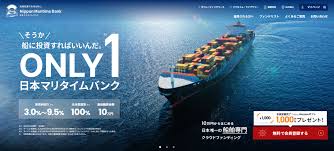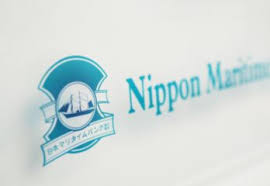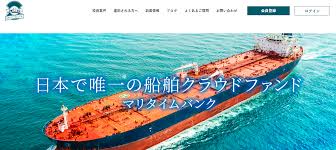〆We sat down with the company’s president, Masashi Hiruta, to discuss this innovative approach to ship investment in Japan.
Nippon Maritime Bank (headquarters in Chuo Word, Tokyo) has introduced Japan’s inaugural lending-based crowdfunding platform. This allows individual investors to invest in ships starting from 100,000 yen through the bank’s website. Since the bank’s inception in March 2022, membership has grown to 5,400, with a future goal of reaching 10,000 members. President Masashi Hiruta shared the company’s strategic vision: “Japan relies on imports for 99.6% of its resources, most of which are transported by sea. By making ship investment more accessible, we aim to integrate this concept into the Japanese market and connect with global shipping companies.”
(Text by Hirofumi Yamamoto)

■The Concept of Crowdfunding
―Crowdfunding involves providing funds to individuals, companies, or organizations through the Internet by a large number of people. What is the objective behind Nippon Maritime Bank introducing crowdfunding for ships?
“I see significant potential in linking the estimated 2,000 trillion yen of individual assets in Japan with global shipping companies. Ships are often perceived as a B2B (business-to-business) domain, an exclusive business for professionals due to the large scale of investment and high level of expertise required. When considering B2C (business-to-consumer) expansion, we needed to establish a crowdfunding platform that allows individuals to invest in units of 100,000 yen. This approach makes ship investment accessible to the general public. I believe our platform can now better meet the diverse funding needs of shipping companies by tapping into Japan’s vast pool of individual assets.”
―How does lending-based crowdfunding work?
“Our method involves raising funds from the general public through our website and lending these funds to overseas operators (shipping companies). This is why it’s called lending-based crowdfunding. Our loans focus on asset finance, emphasizing the profitability and liquidity of the ships used as collateral. For this venture, we have registered for money lending and second-class financial instruments businesses.”

―How will Nippon Maritime Bank respond if foreign operators default due to worsening market conditions?
“Our basic approach is to sell the collateralized vessels to recover funds. While we may collaborate with shipping companies for voluntary sales, there are instances where seizure and auction might be necessary. Our strength lies in our practical capabilities in such situations. One of Japan Maritime Bank’s advantages is its expertise not only in selling used ships but also in scrap sales. With our extensive experience and track record, we can confidently recommend investments to individual investors.”
■Executing Bridge Loans
―I would like to ask about the specific new funding needs you foresee. Additionally, I am interested in the loan achievements since the launch of Japan Maritime Bank.
“Since its inception, Nippon Maritime Bank has organized 24 loan-based crowdfunding projects, raising a total of 14 billion yen. When foreign shipping companies purchase used ships, quick decision-making is essential. However, loan approvals from Japanese banks take time. Japan Maritime Bank addresses this timing gap with bridge loans, offshore ship-backed loans, and scrap project financing, meeting funding needs that traditional B2B financing could not capture.”

―Is your company in competition with Japanese financial institutions?**
“Our company also has a track record of participating in syndicated loans for ships in collaboration with other financial institutions. Specifically, regional banks provide senior loans, while we provide junior loans. For senior lenders, this method reduces the loan amount they need to provide individually and gives them priority in repayment. Additionally, our involvement as a junior lender allows us to share our strengths in creditor monitoring, negotiating terms, and debt recovery, which is highly valued. We do not see ourselves as competitors to banks or leasing companies but rather as partners in creating new projects together.”
■30% are Women
―I heard that the age demographic of individual investors targeted by the Nippon Maritime Bank differs from your initial expectations.
“Initially, we assumed that our target group of individual investors would be senior citizens. However, the reality is that the majority are in their 30s and 40s, with 30% being women. This was a pleasant surprise for me. The younger generation is interested in asset management, and I am confident that the field of ship investment will continue to grow.”
―President Hiruta seems eager to raise public awareness about ships.**
“Despite how integral ships are to our daily lives, most people are unaware of the realities of shipping and vessels. I see it as my mission to educate the general public about shipping and ships, thereby raising maritime investment literacy. On our website, we have a section called the Maritime Library, where we introduce ship valuation, scrapyards, and more. For investors, we offer features that allow them to view their invested ships in 3D, track their current locations, and view their voyage routes, making the experience more tangible.”

―JOLCO (Japanese Operating Lease) is not widely known but is also part of your business.
“Unlike loan-based crowdfunding, this involves a sale and leaseback arrangement. Due to the high cost of ships, this product is aimed at large investors. The target is corporate entities, with an investment amount of 10 million yen, requiring face-to-face contracts. In the case of JOLCO, a Special Purpose Company (SPC) purchases the ship with funds from investors and bank loans, then charters it out. As a financial instruments business operator, we handle investor recruitment and SPC management for JOLCO. Since we started handling it in May last year, we have organized seven deals involving seven ships, with a fund amount reaching 80 million USD (approximately 12.4 billion yen).”
■Profile
Masashi Hiruta graduated from Doshisha University with a degree in law in 1999. After working as a shipbroker, fund manager, and scrapyard operator, he assumed his current position in 2020. He is currently 47 years old.
